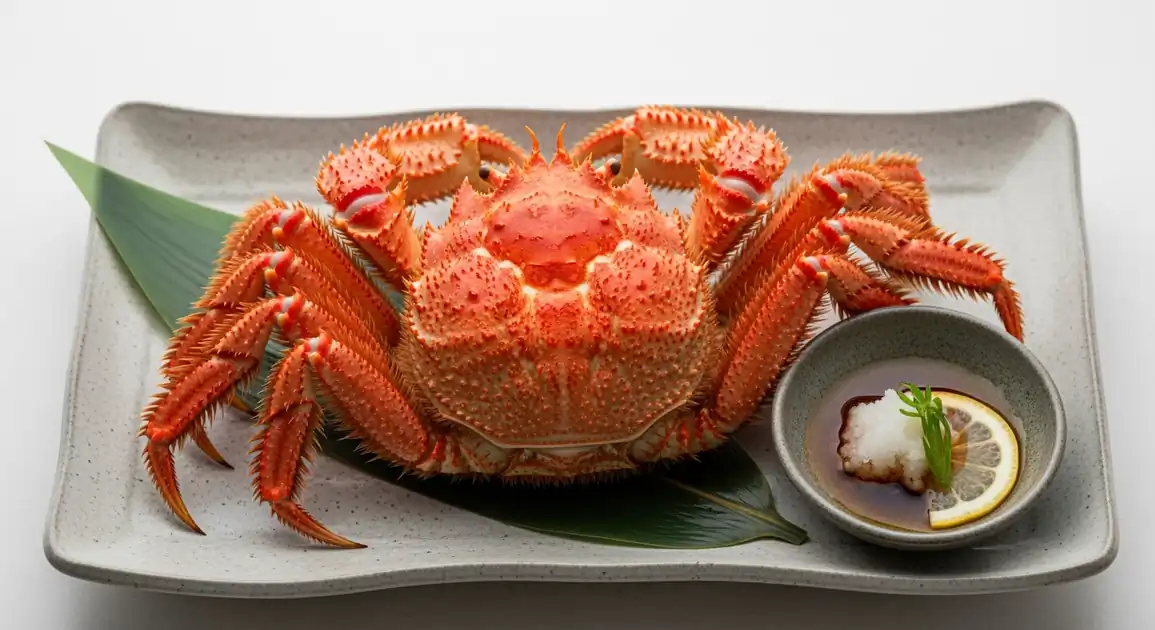Kegani (Horsehair Crab)
毛蟹 (Kegani)

Description
Sapporo, the capital of Hokkaido, is arguably the best city to enjoy fresh Kegani. Numerous seafood markets, like Nijo Market and the Curb Market (Jogai Ichiba), offer live and freshly boiled crabs, often with options to eat immediately. Specialty crab restaurants abound, providing various preparations.
Dietary Information
Serving information
Serving style
Whole boiled/steamed crab ('Sugata-mori') is iconic. Served with dipping sauces (ponzu/vinegar) and crab utensils. Often the centerpiece of a meal.
Quick facts
Nijo Market: Approx. 7 AM - 6 PM (individual stall hours vary). Curb Market: Approx. 6 AM - 5 PM. Restaurants: Lunch 11 AM - 3 PM, Dinner 5 PM - 10 PM.
Safety Tips
What to Look For
-
Bright reddish-orange color (if boiled/steamed).
Indicates proper cooking. Dull or brownish color might suggest staleness or improper cooking.
-
Firm shell and feels heavy for its size.
Suggests the crab is full of meat and miso.
-
Fresh, clean sea smell.
Absence of ammonia or any unpleasant 'off' odors is crucial.
-
Reputable vendor/restaurant.
Choose established markets, specialty crab restaurants, or high-end retailers known for quality seafood.
-
Lively movement (if buying live).
Ensures the crab is healthy and fresh.
-
Proper temperature: Served appropriately hot (if freshly cooked) or well-chilled (if pre-boiled).
Avoid lukewarm crab, which could indicate temperature abuse.
What to avoid
-
Strong ammonia or foul smell.
A definitive sign of spoilage.
-
Dull, discolored, or excessively slimy shell/body.
Indicates lack of freshness.
-
Cracked or significantly damaged shell (unless damage just occurred).
Can sometimes indicate poor handling or older stock.
-
Lightweight crab for its size.
May indicate less meat or miso inside.
-
Vendors with poor hygiene or improper storage (e.g., cooked crab not chilled).
Increases risk of contamination and spoilage.
Price information
Price range
Budget tips
- Buying directly from Nijo Market or the Curb Market and having it cooked there can be cheaper than full-service restaurants.
- Compare prices between vendors at the markets.
- Lunch sets at crab restaurants might offer better value than dinner courses.
Value indicators
- Liveliness of crabs in market tanks.
- Brightness of color and firmness of shell for cooked crabs.
- Reputation of the restaurant or market vendor.
- Clarity on pricing (per crab/weight).
Where to Find This Dish
Nijo Market (二条市場)
Centrally located seafood market where you can buy fresh Kegani and often eat it at adjacent small restaurants or stalls.
Tanukikoji Shopping Arcade vicinity
Morning, Early Afternoon
Sapporo Central Wholesale Market Curb Market (札幌場外市場 - Jogai Ichiba)
Larger market area outside the central wholesale market, with numerous stalls selling fresh seafood including Kegani, and restaurants.
Near Soen Station
Morning, Lunch
Susukino
Sapporo's entertainment district hosts many restaurants, including famous crab specialty chains like Kani Honke and Kani Shogun.
Susukino Crossing, Ramen Yokocho
Dinner
Sapporo Station Area / Odori Park Area
Upscale restaurants and department stores (with 'depachika') offering premium Kegani options.
Sapporo Station, Odori Park, Sapporo TV Tower
Lunch, Dinner, Daytime (Depachika)
Vendor Tips
- At markets, don't hesitate to negotiate slightly, but focus on freshness over the absolute lowest price.
- Confirm if the market stall can cook the crab for you ('Yudete moraemasu ka?') and if there's an extra charge.
- Make reservations for popular crab restaurants, especially during peak season or weekends.
- Be aware that live crab prices fluctuate daily based on market conditions.
How to Order
Regional Variations
-
Market 'Eat-In' Style
(市場内食事)
Many market stalls in Sapporo have adjacent small eateries or counters where you can immediately eat the Kegani you just purchased, often simply boiled.
-
Restaurant Course Menus
(カニコース)
Specialty restaurants often offer multi-course menus ('kani course') featuring Kegani prepared in various ways (boiled, grilled, sashimi, hot pot, etc.).
Cultural context
History
Harvested from the frigid waters surrounding Hokkaido and the North Pacific, Kegani has been a vital part of the region's fishing industry for generations. Initially a local specialty, advancements in transportation and refrigeration allowed its popularity to spread across Japan, where it is now revered as a premium seasonal ingredient. It embodies the rich seafood culture of Hokkaido and is often associated with winter feasts and special occasions.
Local significance
Kegani is a major culinary draw for Sapporo and Hokkaido. Trying fresh Kegani is a highlight for many visitors.
Eating customs
- Focus is on appreciating the natural flavor.
- Using provided tools efficiently is part of the experience.
- Sharing a large crab among a group is common.